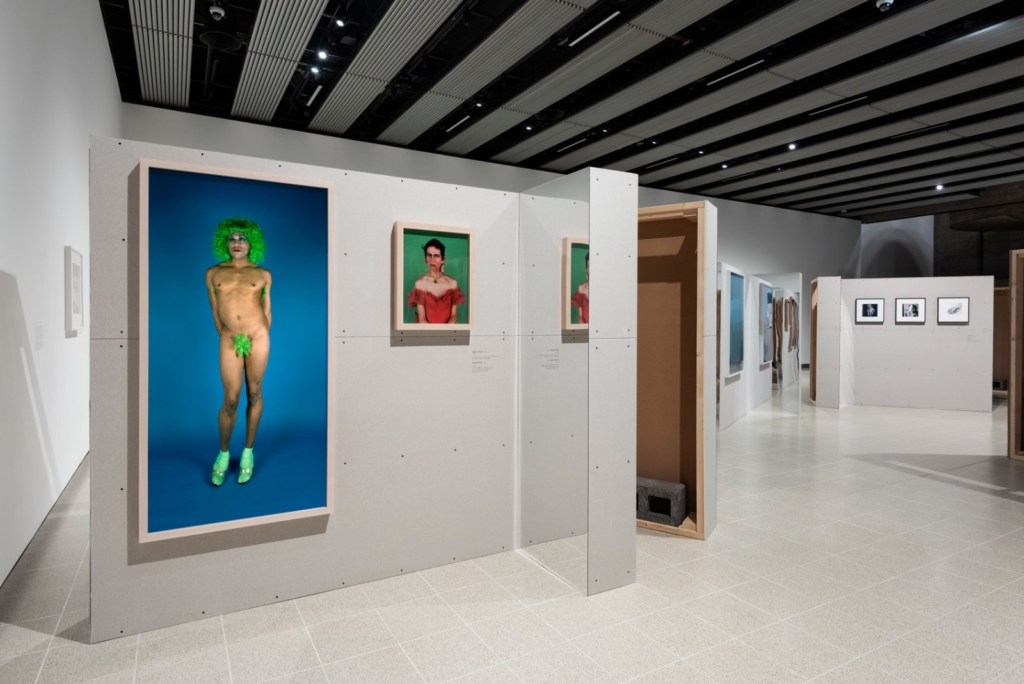


Catherine Opie(from a vogue article)
Regarded as one of the greatest living documentarians of the American landscape, both sociopolitically and literally, Opie chronicles everything from queer subcultures to urban development, reflecting her interest in gender, identity and community. In 2009, her photographs of Lake Michigan caught the eye of Barack Obama, who had the works mounted on the walls of the White House, where they remained during his presidency.
“I get mistaken for being a ‘sir’ all the time. In Being and Having, I was thinking about my friends and how we performed masculinity and butchness — at the time, a lot of us did drag at a great club in Los Angeles, Club Fuck. In each portrait, I wanted to take [the subject] out of their environment; I shot them against a yellow backdrop and cropped it so you focus on the fake moustaches they’re wearing. At one of my exhibitions, someone confused these people for men. I said, ‘You do realise these are all lesbians wearing fake moustaches?’. I find it interesting that when people see facial hair, they just assume it’s a man.





Catherine Opie’s photography has many factors of stereotyping what men and women should be seen as, and not what they chose to become, although men and women are seen as very different you shouldn’t portray a certain expectation from them. I believe that women and men should have there own preference as long as it stays respectful to each gender, for example it wouldn’t be right for a man to dress up as a women and make fun of them for ow they would dress or how they act by imitating certain feminine actions. There are different types of people and styles that are more feminine and masculine, as for in the photos they seem to be bikers that ride big bikes, therefore they are dressed in quick thick leather jackets, most have short hair and wear big chains/ necklaces. This doesn’t make the style specific to a specific gender but does portray certain clothing’s men tend to wear. At the top the 3 photos I chose to use as a mood board represent how boys should be seen and how some are seen as more feminine, the middle photo is unidentified as a girl or a boy as there facial features are show, personally I would say it is a girl but wouldn’t assume as that can effect someone’s well being. The top right and left photo are pictures of ‘boys’ stereotypically shown as they are seen playing sports. However the middle picture is a girl to me as they are wearing jewellery although they have very short hair they still have most of the feminine features. Catherine Opie has a very unique photography styles where she takes portraits of people and presents them as that without adding any exposure to the editing, she left them photo quite clean and basic so we could really focus on the persons facial features. She is also known for creating openly lesbian artist who is part of often denigrated queer subcultures, Opie has spent much of her career documenting underground, subversive, and outsider communities – using extremely stylized, formal conventions of portrait photography to frame unconventional subjects, including herself.


she even has some of her work put up in a gallery, this shows how important and how it has impacted so many people as it lets people to open up as find a way to express themselves without getting judged.
I would quite like to recreate her work with some of my own twists to the work, I could use some of my lightening techniques that I learnt to add a better effect to the photo. I would quite like my model to still do similar positions as poise models do, but I would try and get some feminine girls and masculine boys. This would make the artists work very different to mine yet very similar as her work is seen as more focused on masculinity and how every gender can express it, for example she has a theme of bikers, which is stereotypically more known for men. This is where I can add some of my own ideas where I switch it up to juts a feminine stereotype.

Chanelle, both artists case studies are good, providing critical analysis and perspectives by including quotes and references to artists’ own words and the view of others on their work, method and practice. The only thing to add is explaining how you wish to develop your own ideas/ photoshoots in response to artists research.
In preparation for Mock Exam on Wednesday 24 Jan, make sure you complete and publish following missing blog posts:
1. One more Photoshoots + image selection and adjustments
2. Continue to show experimentation with images in LR or Photoshop etc